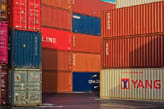In today's globalized world, sea freight plays a crucial role in international trade. Among various shipping methods, container shipping has become the most popular and efficient one. This article aims to provide an overview of sea freight, focusing on the process of shipping goods in a full container load (FCL).
The first step in the FCL shipping process is to book a container. A container is a large, weatherproof box, usually made of steel, designed to carry goods. There are various types of containers available, such as 20-foot container (20' container), 40-foot container (40' container), and 45-foot container (45' container). The choice of container size depends on the volume and weight of the goods to be shipped.
Once the container is booked, the shipper needs to prepare the goods for shipping. This includes packing the goods securely and ensuring they are loaded into the container without any damage. The goods should be properly labeled with the destination address, consignee's name, and any other necessary information. It is also essential to comply with international shipping regulations and standards, such as ISPM 15, which requires wood packaging material to be treated to prevent the spread of pests.
After the goods are loaded into the container, it is sealed and secured. The shipper will then receive a bill of lading (B/L), which is a legal document that serves as evidence of the contract of carriage between the shipper and the carrier. The B/L contains important information, such as the description of the goods, the container number, the origin, and the destination.
The next step is to transport the container to the port of origin. This can be done by road, rail, or a combination of both. Depending on the distance and the availability of transportation options, this process may take a few hours to several days.
Once the container arrives at the port of origin, it will be inspected by customs officials. They will verify the contents of the container, check for any prohibited items, and ensure that all documentation is in order. If everything is in compliance, the container will be loaded onto a cargo ship for transportation to the destination port.
The journey by sea can take anywhere from a few days to several weeks, depending on the distance and the route. During this time, the container will be stored in the ship's cargo hold, protected from the elements and theft.
Upon arrival at the destination port, the container will be unloaded and transported to the customs office. Customs officials will inspect the container again to ensure that all goods are as described in the B/L and that they comply with local regulations. Once cleared, the container will be delivered to the consignee or their agent.
The consignee will then be responsible for unloading the goods from the container and distributing them to their final destinations. This may involve further transportation by road, rail, or air, depending on the requirements of the consignee and the final destination of the goods.
In conclusion, sea freight, particularly FCL shipping, is a critical component of international trade. By understanding the process of shipping goods in a full container load, businesses can ensure that their products are transported efficiently and safely. From booking a container to the final delivery of the goods, every step in the process requires careful planning and attention to detail. By working with reliable shipping partners and adhering to international shipping regulations, businesses can maximize the benefits of sea freight and contribute to the growth of global trade.

——END——
https://www.fanjue56.com/guojihuodai/93263.html,以上就是海运整柜的英文的解读,只要通过预约方式联系我们的顾问客服根据不同进口产品, 即可获得国际货运方案和进口报关代理报价单,手续费低,省钱,省心。工作人员看到您的信息会第一时间与您联系,文章图文源于网络和投稿、即编辑排版,传递更多知识,如涉及版权,请及时联系我们会尽快处理。如果您还有其他疑问,欢迎致电400-0031-521.

